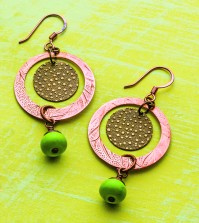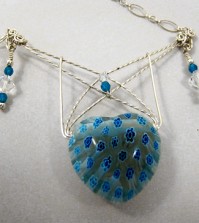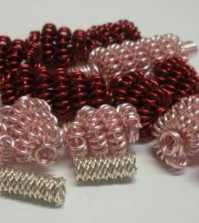- NEW DVD Series – Stone Setting with Bezels
- Tube Set Charm by Kim St. Jean
- Prong Basket Pendant by Kim St. Jean
- NEW DVD Series – Stone Setting with Cold Connections
- New DVD Series – Stone Setting with Wire
- NEW DVD Series: Introduction to Stone Setting by Kim St. Jean
- Featured Tool: Bracelet Bending Plier
- NEW Dvd by Eva Sherman
- Fun, Fast Fold Forming DVD Series
- Double Band Ear Cuff from Alex Simkin
Gem Profile Mar. 15: Where Paua and Abalone Come From
by Layna Palmer, Wire-Sculpture.com

Nautilus, Abalone, Paua,
& Pinctada Maxima:
The Cephalopods, Bivalves, and Gastropods` Shells used in Jewelry
Shop Mother of Pearl Cabochons | Shop Shell Cameos | Shop Mother of Pearl Beads | Shop Mother of Pearl Carvings
Ah, spring! My tulips and daffodils are starting to come up and the air has that warmth to it that is a welcome change from the winter cold. Now I just have to start worrying about snails coming out to eat the garden. Speaking of snails, I think we will start this week`s Gem Profile on Cephalopods and the Mother of Pearl that comes from them.

Cephalopods: Nautilus and Ammonites
Cephalopods are a class of mollusks that include octopuses, squid, cuttlefish, nautiloidea or Nautilus, and fossils like Ammonite and belemnite. Obviously octopuses, squid, and cuttlefish don`t have the ability to give us mother-of-pearl (MOP) because they don`t have a shell, but the Nautilus has a smooth inner shell that has little or no banding with a beautiful iridescence very similar to pearls and is used for the white MOP faces on watches.

Nautiluses are found in the warm waters of the southwest Pacific Ocean, Indian Ocean, and off the coast of Australia. Nautilus shells are spiral with pockets throughout them that hold oxygen and nitrogen; giving them some buoyancy in water… they don`t sink. The Nautiluses are free-swimming predatory creatures that swim through the water by `jet propulsion,` feeding on crustaceans. They are fairly unattractive, but they do give us some beautiful material from their shells, and their fossilized ancestors are highly prized for their opalescence and beauty.

Bivalves: Mussels, Pinctada Maxima, and Oysters
Next are Bivalves, or Bivalvia, which include clams, mussels, oysters and scallops. These are the two-shelled creatures whose shells are hinged on one side, and open on the other. Scallops are swimmers, but we don`t use them for MOP – but they`re good to eat! In jewelry, we use oysters and mussels from this family.

Oysters not only give us pearls, but they are a huge source of MOP in the jewelry industry. Pinctada Maxima is another type of oyster that produces some of the finest pearls in the world. South Sea pearls come from the pinctada maxima and the nacre color of the MOP is the same color as the pearl within. These mollusks are very large and easier to cultivate than other oysters so the nucleus used as cultivation for South Sea pearls can be larger. Mussels also give us pearls and are the source of freshwater pearls and MOP.

What a way to recycle! The food industry uses the meat of oysters and mussels then passes the shells on to the jewelers for MOP inlays, jewelry and other decorative items. Shells from bivalves are also used as a dietary supplement for poultry and as calcium supplements for humans. Crushed shells are used to remove heavy metals from water in areas like the Persian Gulf and the live animals can act as biofilters in some areas as well.

These shells are also a symbol of St. James and the Roman myth recounts that Venus, the goddess of love, was born from the shell of a bivalve. In my own garden, I have a birdbath in the shape of a clam and have used shells on several of the stepping stones around my yard too. Look around and you will find the bivalve in many of the symbols we see every day.
Gastropods: Paua and Abalone Shells
Now we get to the gastropods, or gastropoda mollusk. Gastropods are a very scientific name for a snail or slug. I know, I hate them too; they eat my garden and are just generally icky, although escargot is not bad. Gastropods are recognized by having a `foot` reaching out of their shell, which they use to cling to rocks and surfaces.

Gastropods, as icky as they are, contain a huge number of species – second only to insects in number. For this conversation, we will be focusing mostly on abalone.

Abalone is the generic name for the many species of the genus Haliotis (no, they don`t have bad breath). Paua (pronounced pow-a) is the name the Maori people gave to this large edible sea snail that lives in the shallow coastal waters along the rocky coast of New Zealand. In the United States and Australia, we call them abalone, but the United Kingdom calls them ormer shells. Abalone are also found on rocky coastlines in shallow water where they cling to the rocks with a `foot` and feed on seaweed… see, all snails like green stuff! (Click here to see a picture of a growing abalone, photo by Genny Anderson)
Paua grow very large and have strict rules on their harvest. In New Zealand, `wild` paua are only to be harvested by free diving (read: no scuba equipment), and in restricted numbers per day. Similar restrictions are in place along the coast of California, where poaching abalone is strictly prohibited, and can be very dangerous. New Zealand also has a burgeoning industry of paua farms, which are located throughout the country.

Paua farmers raise the critters for their meat and shells, which are exported primarily to the United States and Asian markets. Paua farming can be expensive to set up and maintain due to the size and activity level of the mollusk. Farming helps not only with supply of meat and shells, but also helps prevent overfishing, and produces a higher quality of product.
Paua, or abalone, shells are used in jewelry making, and can also be dyed or tinted to a rainbow of colors that are enhanced by the iridescence of the nacre which creates the shells. The shells have also been used throughout history in rites and rituals throughout the world, most notably in Native American rituals and Maori ceremonial masks and rites.

Paua shells, noted for their banded rainbow colors, can also create pearls. Paua pearls, or blue pearls, are formed when a small irritant like a grain of sand gets between the mollusk and its shell. Similar to a mabe pearl (a half-round pearl), the blue pearl is the iridescence of the paua MOP and highly prized for its beauty. Blue pearl production is highly controlled on paua farms so as not to stress the animal to maximize the beauty of the pearls.

Though writing about abalone and MOP has given me a little more respect for the lowly snail, I still don`t like it in my garden, but I love the look of Mother of Pearl and will use it more in my jewelry! I think next week we`ll take a look at the other types of mollusks like conch and cowries, and the beads and shells we use from them as well.
Do you have conch shells you`ve collected from the beach, or jewelry you`ve made from cowrie shells? Send pictures our way at tips@wire-sculpture.com and they could be featured next week when we talk about conch and cowry shells!
Resources & Recommended Reading
- Gastropoda
- Paua
- Bivalve molluscs
- Cephalopod
- New Zealand guide to Fish Identification: Paua
- Malibu Divers: Abalone Divers
Gem Profile by Layna Palmer
Click to Receive Daily Tips by Email























Irv Baker
March 15, 2013 at 9:16 am
Hi,
I use abalone shell a lot and you haven’t mentioned the care needed when cutting and polishing shells. The dust is very toxic.